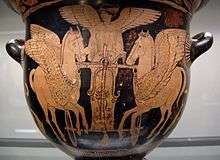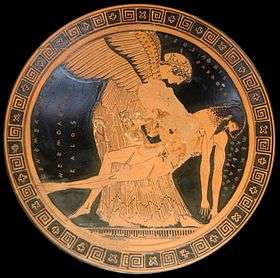Eos
| Eos | |
|---|---|
| Goddess of the Dawn | |
 Eos (1895) by Evelyn De Morgan | |
| Abode | Sky |
| Symbol | saffron, cloak, chariot, horse, roses, tiara, grasshopper, cicada, cricket |
| Consort | Astraeus |
| Parents | Hyperion and Theia |
| Siblings | Helios and Selene |
| Children | Anemoi |
| Roman equivalent | Aurora |
In Greek mythology, Ēōs (/ˈiːɒs/; Ionic and Homeric Greek Ἠώς, Attic Ἕως Éōs, "dawn", pronounced [ɛːɔ̌ːs] or [héɔːs]; Aeolic Αὔως Aúōs, Doric Ἀώς Āṓs) is a Titaness and the goddess[1] of the dawn, who rose each morning from her home at the edge of the Oceanus.
Eos had a brother and a sister, Helios, god of the sun, and Selene, goddess of the moon.
Etymology
Eos is cognate to Vedic Sanskrit Ushas and Latin Aurora (Old Latin Ausosa), both goddesses of dawn, and all three considered derivatives of a PIE stem *h₂ewsṓs[2] (later *Ausṓs), "dawn", a stem that also gave rise to Proto-Germanic *Austrō, Old Germanic *Ōstara and Old English Ēostre/Ēastre. This agreement leads to the reconstruction of a Proto-Indo-European dawn goddess.
Greek literature
| Greek deities series |
|---|
| Titans |
|
The dawn goddess Eos was almost always described with rosy fingers (ῥοδοδάκτυλος, rhododáktylos) or rosy forearms (ῥοδόπηχυς, rhodópēkhys) as she opened the gates of heaven for the Sun to rise.[3] In Homer,[4] her saffron-coloured robe is embroidered or woven with flowers;[5] rosy-fingered and with golden arms, she is pictured on Attic vases as a beautiful woman, crowned with a tiara or diadem and with the large white-feathered wings of a bird.
From The Iliad:
Now when Dawn in robe of saffron was hastening from the streams of Oceanus, to bring light to mortals and immortals, Thetis reached the ships with the armor that the god had given her.— Iliad xix.1
But soon as early Dawn appeared, the rosy-fingered, then gathered the folk about the pyre of glorious Hector.— Iliad xxiv.776
Quintus Smyrnaeus pictured her exulting in her heart over the radiant horses (Lampus and Phaëton) that drew her chariot, amidst the bright-haired Horae, the feminine Hours, climbing the arc of heaven and scattering sparks of fire.[6]
She is most often associated with her Homeric epithet "rosy-fingered" (rhododactylos), but Homer also calls her Eos Erigeneia:
That brightest of stars appeared, Eosphoros, that most often heralds the light of early-rising Dawn (Eos Erigeneia).— Odyssey xiii.93
Hesiod wrote:
And after these Erigeneia ["Early-born"] bore the star Eosphoros ("Dawn-bringer"), and the gleaming stars with which heaven is crowned.— Theogony 378-382
Thus Eos, preceded by the Morning Star, is seen as the genetrix of all the stars and planets; her tears are considered to have created the morning dew, personified as Ersa or Herse.{Ovid, Metamorphoses 13.621-2} Eos is the daughter of Hyperion, a bringer of light, the One Above, Who Travels High Above the Earth and of Theia, The Divine. Her brother was the Sun god Helios, and her sister was Selene, the Moon goddess. Her team of horses pull her chariot across the sky and are named in the Odyssey as Firebright and Daybright.
She was the Mother of several notable offspring, including the Winds, Zephyrus, Boreas, and Notus, and the Morning Star, Eosphoros, all of whom she bore to the Titan Astraeus ("of the Stars"), and Memnon, her son by Tithonus.
This rosy-fingered, saffron-robed and golden-throned goddess, who goes up to Olympus to announce the light to the immortals, fell in love several times, and some say it was Aphrodite who cursed her to be perpetually in love, because once had Eos lain with Aphrodite's sweetheart Ares, god of war.
Genealogy
Eos is the daughter of Hyperion and Theia and sister of Helios the sun and Selene the moon, "who shine upon all that are on earth and upon the deathless gods who live in the wide heaven." Hesiod told in Theogony (371-374). The generation of Titans preceded all the familiar deities of Olympus, who largely supplanted them.
Lovers and children

According to Pseudo-Apollodorus, Eos consorted with the war god Ares and was thereupon cursed with unsatisfiable sexual desire by the jealous Aphrodite.[7] This caused her to abduct a number of handsome young men, most notably Cephalus, Tithonus, Orion, and Cleitus. The good-looking Cleitus was made immortal by her.[8] She also asked for Tithonus to be made immortal, but forgot to ask for eternal youth, which resulted in him living forever as a helpless old man.[9]
According to Hesiod[10] by Tithonus Eos had two sons, Memnon and Emathion. Memnon fought among the Trojans in the Trojan War and was slain. Her image with the dead Memnon across her knees, like Thetis with the dead Achilles are icons that inspired the Christian Pietà.
The abduction of Cephalus had special appeal for an Athenian audience because Cephalus was a local boy,[11] and so this myth element appeared frequently in Attic vase-paintings and was exported with them. In the literary myths[12] Eos kidnapped Cephalus when he was hunting and took him to Syria. The second-century CE traveller Pausanias was informed that the abductor of Cephalus was Hemera, goddess of Day.[13] Although Cephalus was already married to Procris, Eos bore him three sons, including Phaeton and Hesperus, but he then began pining for Procris, causing a disgruntled Eos to return him to her — and put a curse on them. In Hyginus' report,[14] Cephalus accidentally killed Procris some time later after he mistook her for an animal while hunting; in Ovid's Metamorphoses vii, Procris, a jealous wife, was spying on him and heard him singing to the wind, but thought he was serenading his ex-lover Eos.
Etruscan interpretations
Among the Etruscans, the generative dawn-goddess was Thesan. Depictions of the dawn-goddess with a young lover became popular in Etruria in the fifth century, probably inspired by imported Greek vase-painting.[15] Though Etruscans preferred to show the goddess as a nurturer (Kourotrophos) rather than an abductor of young men, the late Archaic sculptural acroterion from Etruscan Cære, now in Berlin, showing the goddess in archaic running pose adapted from the Greeks, and bearing a boy in her arms, has commonly been identified as Eos and Cephalus.[16] On an Etruscan mirror Thesan is shown carrying off a young man, whose name is inscribed as Tinthu.[17]
Roman interpretations
The Roman equivalent of Eos is Aurora, also a cognate showing the characteristic Latin rhotacism. Dawn became associated in Roman cult with Matuta, later known as Mater Matuta. She was also associated with the sea harbors and ports, and had a temple on the Forum Boarium. On June 11, the Matralia was celebrated at that temple in honor of Mater Matuta; this festival was only for women during their first marriage.
See also
Notes
- ↑ Lycophron calls her by an archaic name, Tito (the Titaness). Kerenyi observes that Tito shares a linguistic origin with Eos's lover Tithonus, which belonged to an older, pre-Greek language. (Kerenyi 1951:199 note 637)
- ↑ R. S. P. Beekes, Etymological Dictionary of Greek, Brill, 2009, p. 492.
- ↑ Nonnus: "Eos had just shaken off the wing of carefree sleep (Hypnos) and opened the gates of sunrise, leaving the lightbringing couch of Kephalos." (Dionysiaca 27. 1f, in A.L. Rouse's translation).
- ↑ Iliad viii.1; xxiv.695
- ↑ Odyssey vi:48 etc
- ↑ Posthomerica i.48
- ↑ Pseudo-Apollodorus, Bibliotheca, 1. 4. 4
- ↑ Homer, Odyssey, 15. 249 ff
- ↑ Homeric Hymn to Aphrodite, 318 ff
- ↑ Theogony 984ff
- ↑ Mary R. Lefkowitz, "'Predatory' Goddesses" Hesperia 71.4 (October 2002, pp. 325-344) p. 326.
- ↑ Hesiod Theogony 984; pseudo-Apollodorus Bibliotheke iii. 14.3; Pausanias i. 3.1; Ovid Metamorphoses vii. 703ff; Hyginus Fabula 189.
- ↑ Pausanias remarking on the subjects shown in the Royal Stoa, Athens (i.3.1) and on the throne of Apollo at Amyklai (iii.18.10ff).
- ↑ Hyginus, Fabula 189.
- ↑ Marilyn Y. Goldberg, "The 'Eos and Kephalos' from Cære: Its Subject and Date" American Journal of Archæology 91.4 (October 1987, pp. 605-614) p 607.
- ↑ Goldberg 1987:605-614 casts doubt on the boy's identification, in the context of Etruscan and Greek abduction motifs.
- ↑ Noted by Goldberg 1987: in I. Mayer-Prokop, Die gravierten etruskischen Griffspiegel archaischen Stils (Heidelberg) 1966, fig. 61.
References
- Grimal, Pierre, The Dictionary of Classical Mythology, Wiley-Blackwell, 1996, ISBN 978-0-631-20102-1. "Eos" p. 146
- Kerenyi, Karl. The Gods of the Greeks. Thames and Hudson, 1951.
- Smith, William; Dictionary of Greek and Roman Biography and Mythology, London (1873). "Eos"
External links
| Wikimedia Commons has media related to Eos. |
